The Isaac Lord buildings
'ISAAC LORD' (just visible) lettered either side of the middle loading
door
displaying the white architect's sign (photo below left):
 -
-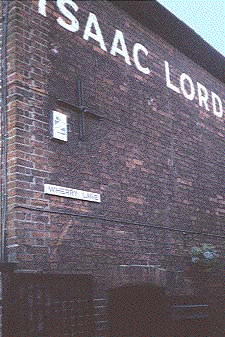
At the far end of Wherry Lane: above and to the left of The John
Russell
Art Gallery (photo above right).
Back on the quayside, the warm Suffolk reds on the face of the ancient
building,
discoloured above, set off the white lettering; next door is the former
Malt Kiln pub:
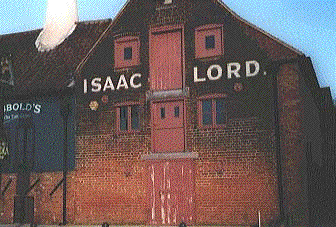 -
-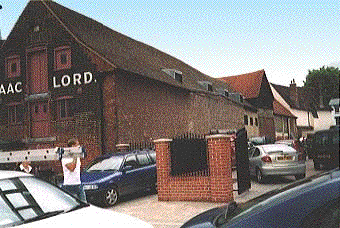
The photograph above right shows the whole rake of linked buildings,
running
back to Fore Street.
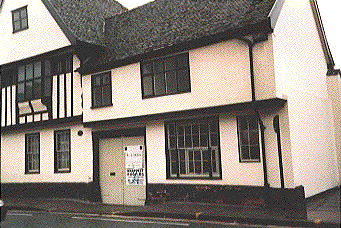
Here is the Fore Street facade of the Isaac Lord buildings (facing The
Lord
Nelson pub) which dates back to the time of merchant Henry Tooley (died
1551),
benefactor
of Tooley's Almshouses in Foundation
Steet.
The dual race-tracks which currently cut off the Wet Dock from the main
part of the town have much to answer for. Not least, the ignorance of
many
(including us until the Heritage Open Days in 2002) about this gem.
Fore
Street was a bustling dockland street in the heyday of shipping at the
Wet
Dock. Wool and grain by the cartload, Gascon wine and Icelandic cod,
dockers
and sailors and all that came with them: pubs, brothels, pawnbrokers
such as Sneezums further up Fore Street, extreme
poverty
and wealthy merchants' houses. The ideal spot for your dwelling was
clearly
fronting Fore Street, so that you could show off your status by
handsome,
carved breast-summer (pronounced 'bresummer') beams (these examples are
situated above and below the timbered section at left of the frontage.
These
merchants' houses could then be linked to warehouses, granaries and
maltings
stretching right down to the quayside. The merchant could keep an eye
on
his workers - and his ships coming in - and live not above, but in
front/back
of the shop. Here are the numerals and lettering carved and highlighted
in the bresummers:
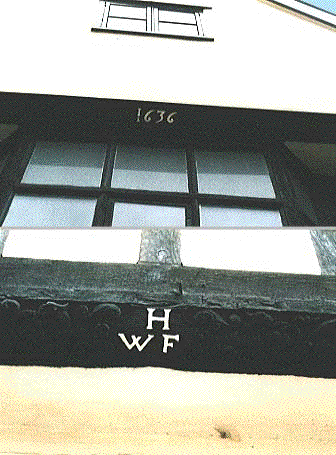
Meanwhile ...
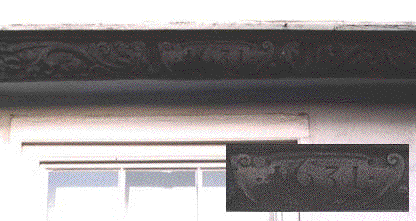
[Another, even older, bresummer beam exists not far from here in
Grimwade
Street clearly dated in the carved decoration: '1631'. The long beam
runs
from No. 79 to No. 83, with the date shield above the entrance to No.
81;
it is curved with age and building movement over the centuries, but the
sharpness of the carving is remarkable. The building bears an historic
landmark
plaque telling us that it was called 'The Captain's Houses': reputed to
be the home of 176 sea captains.]
Sadly, the present owners of Isaac Lord's, busy in restoring the only
surviving
rake of buildings between Fore Street and the quay (the Neptune nearby
has
sold off its buildings adjacent to the quay) are unable to identify the
worthy whose initials are 'H.W.F.', though '1636' is certainly the date
of erection of this part. On the other side of the archway into the
yard
is a more modest house facade, also owned by the same family.
Dendrochronology
reveals that an internal beam was felled in the spring of 1478 and so
the
date of erection was about 1480. This is claimed to be is the oldest
surviving
dwelling house in the town. Older than the Ancient House - the core of
ther
oldest part is the 'Chapel Room' leading off the art gallery above
Lakeland
Kitchenware - and the Sun Inn (more recently Atfield & Daughter:
collector's
bookshop) in St Stephens Lane, another fine old building being lovingly
restored by the owner family. It is arguable that Pykenham's Gatehouse
-
opposite the County Library in Northgate
Street
(built in 1471 and famous for its Tudor brick front: all that remains
of
the former Archdeacon's Palace) has an earlier claim. But is it a
'house'?
Also the cottages behind St Mary at Elms
may
lay claim to this title.
The Isaac Lord story continues.
At number 97 Fore Street, almost opposite the Isaac Lord frontage is a
survivor
from the days when this was the bustling heart of the town and
proprietors were proud to display their names and trades on frosted
glass shop doors. Now the Labour Party Eastern Region offices (note the
posters on the office wall in the second picture), 'E. Jowles -
Chemist' with decorative border and a pestle and mortar motif is
displayed in curly decorative font, the name curving round the motif
and the frosted background following that curve. Unfortunately this
would have been easier to photograph if the white back of a leaflet
stand hadn't been placed against the inside of the door; however, it's
even worse now as there are security bars against the inside of the
glazed door and
it obscures the lettering even more. The third photograph shows that
this double-fronted shop with its curved top windows would have been
quite an impressive emporium. Apart from the recently lost
'Jugs' frosted door on the Duke of York public house on Woodbridge
Road, we don't know of any other examples in Ipswich. Do you?
 -
- -
-
See also Symonds Chemist for a chimney
sign and Hales Chemist for a doorstep
sign.
Home
Copyright throughout this site belongs to Borin Van Loon, 2003.
 -
- -
-
 -
-
 -
-



 -
- -
-